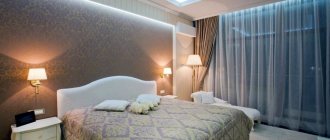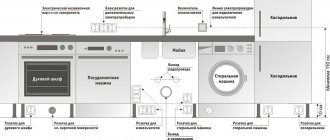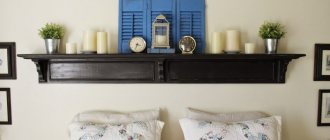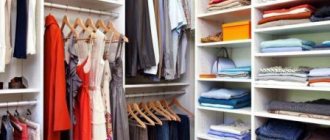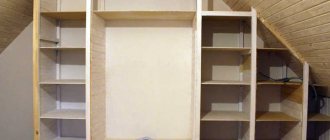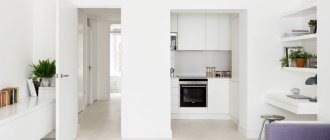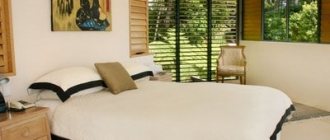Repair
0
8 639
Share
Shelves are an integral part of any closet. Their quantity and ergonomic location directly affect the quality of storage of things and the ease of use. For demanding owners, the aesthetic appearance of placing items in the storage area is also very important.
- Preparing shelves before installation
- What material to buy
- Trimming with a saw to the optimal size
- Veneer edge band
- Methods for arranging shelves and their fastening
- Corner screed
- Screw tie
- Dowel
- Euroscrew
- Conical coupler
- Eccentric coupler
WATCH THE VIDEO
Often, the degree of convenience in the arrangement of shelves is revealed only during the operation of the furniture. To understand how to add shelves to a closet, you need to know some nuances:
- what types of fastening are there;
- what tools to use;
- what material is better to choose;
- how to correctly determine the size of the built-in part.
Types of fastenings for different shelves
There are three main types of shelves used in modern furniture:
- Wooden. The material is chipboard or MDF. The most common type.
- Glass. Manufactured from tempered glass through special thermochemical treatment. As a result, additional strength is provided, which allows them to be used in furniture production.
- Mesh or wire. They are a wire frame in the form of boxes or baskets.
Today, shelves are made from almost any material, including glass.
There are additional modifications to the shelves, such as folding, pull-out or height-adjustable. However, no specially designed type of fittings (with the exception of retractable ones) are used for their installation.
Shelves can have various modifications, including retractable mechanisms.
Mounting options
Attaching shelves with your own hands is an important element in making a wardrobe. The strength of the structure depends on how securely they are fastened.
Installation is not very difficult and does not require special skills. The main thing is to make the calculations correctly and arm yourself with a set of tools. When marking, it is important to strictly observe horizontal levels, otherwise the weight on the shelf will be incorrectly distributed, placing an increased load on one of the fasteners. As a result, such an oversight will lead to breakage of the part.
- Furniture corner. The simplest, strongest type of fastener that does not require additional holes in the panels. There are 2 types of corners - plastic, metal. But they have a drawback: such fasteners are too noticeable.
- Euroscrew. It is screwed into the end of the shelf with the previously made hole. Like the screw tie, the Euroscrew heads are visible on the front side of the panel. Most often, products with a diameter of 7 mm and a length of 50-70 mm are used. To install them, drill 2 holes, into the end of the shelf and into the face of the part. The disadvantages include the fact that such furniture cannot be assembled and disassembled more than 3 times, since the fastenings are destroyed. Also on the sides of the furniture you can see the caps or plugs of the Euroscrews.
- Eccentric coupler. One of the most popular and reliable types of fasteners. The advantage is obvious: furniture with an eccentric tie can be assembled and disassembled many times without fear of consequences. How fastening occurs: an eccentric rod is screwed into the face of a part to which another part is attached at the end; in turn, the eccentric itself is screwed into it through the end of the other shelf, and then the eccentric turns the rod into itself.
Holder for glass shelf in cabinet
There are two most common types of glass shelf holders.
Special holders have been developed for glass ones.
Classic, support
In general, they represent a pin design and are structurally divided into two parts: countersunk and supporting. The first part is usually mounted into the wall. Support – designed directly to hold the plane of the shelf. It is made in the form of a platform: simple, coated, with a plastic gasket or an installed suction cup. Allows you to remove shelves without using tools.
Various modifications of classic holders may look different.
"Pelican": plug-in, with lock
This type of fastening can have different designs, but fundamentally it also consists of two parts: secret and receiving. The hidden part allows you to install fasteners on the cabinet wall, and the receiving part contains a groove where the glass is inserted and secured with a clamp. Installation requires a screwdriver or a special wrench.
Pelican holders look like this.
Attaching mesh shelves
Such shelves are often used in kitchen cabinets or wardrobes. If in the kitchen they are used, as a rule, for storing (drying) dishes, then fastening the shelves in the built-in wardrobe may require special reinforcement (in addition to the standard one or the one that comes included), since in this case mesh shelves are most often used for storage shoes
Such shelves are used in kitchens to store dishes. This imposes its own requirements due to the heavy load and increased size. In general, the mount is a stop with a pin part for mounting and a groove for placing the frame wire.
As a rule, they are attached to a supporting part.
Features of shelves for a closet in the hallway
In such a closet, outerwear will be stored on hangers, and on the shelves - those that are not worn this season. Shoes, small items and accessories, and also, as an option, large household appliances or cleaning products - a vacuum cleaner, seams, brushes, rags.
The closet in the hallway will not be as deep as in the bedroom, because it usually cannot be made larger due to limited space. This is 40 cm (and also for the sliding mechanism).
For clothes
Hangers on a standard rod will no longer fit here. It is worth placing them parallel to the back wall on a retractable or fixed rod. Two rows of such hangers can fit the same amount of clothes as a regular long hanger.
And for clothes from other seasons that are not yet worn, wide shelves in the upper part are suitable.
For shoes
Mesh shelves are suitable, where couples can fit in a row. It will be convenient to take boots and shoes from the shelves located at an angle. For seasonal shoes - drawers, baskets or regular shelves.
For little things
Usually, pull-out shallow drawers are ordered. They are convenient for storing belts, gloves and jewelry.
The cabinet can be supplemented with side shelves on one or two sides.
Installing shelves in a closet: types of fasteners
Furniture fastening fittings vary both in purpose and in the nature of the connection provided.
Fasteners for shelves differ in purpose and nature of the connection. According to the purpose of the fastener, there are:
- Frame.
- Mounting.
- Power.
By the nature of the connection:
- Collapsible.
- Non-separable.
Typically, fastening involves the use of tools such as a drill, forstner cutters, countersinks, screwdrivers, hex keys, chisels, and wood glue. In addition, some types of fasteners require the use of very specific tools, which imposes restrictions on the possibility of their use (Lamello Invis screed).
To attach the shelves you will need certain tools.
Before choosing the type of fastener, you should carefully consider the nature of the cabinet's use, so that later you can ensure trouble-free servicing of individual elements or complete disassembly.
Euroscrews (Euroscrews, confirmats)
Used to connect wooden furniture elements (chipboard, MDF). Such fasteners for a shelf in a closet impose a requirement for a wall thickness of at least 16 mm. Confirmations are manufactured in a certain range of lengths, from 20 to 70mm.
The wall for such fastening should be no thinner than 16 mm. To prepare the mounting hole, special drills with a countersink part at the base are required, as well as special keys to fix it in place. They are relatively easy to assemble, but may not be suitable for all types of furniture, since the screw head remains open. In addition, euroscrews do not allow organizing the longitudinal arrangement of shelves at the same height in the presence of vertical jumpers.
Such fastenings are quite reliable.
Fastenings for shelves in the closet: rastex (minifix)
This fittings belong to the so-called eccentrics, which indirectly indicates their principle of operation. This type of fasteners provides good joint strength, but is difficult to prepare, as it requires great precision in drilling holes. Structurally, it consists of a sleeve for the pin (footer), the pin itself, and a tension sleeve.
This is what Rastex fasteners look like. The footer is installed in the cabinet wall, in a previously prepared place. A pin is screwed into it. For the tightening sleeve, a piece of wood is selected with a milling cutter so that it fits flush into the shelf. A hole for the pin is drilled perpendicular to it, from the end. After the connection is assembled, the bushing pulls the pin and clamps it, thanks to the groove in the sidewall (hence the ex src=»https://severdv.ru/wp-content/uploads/2020/07/sverlenie-dlya-rasteksa.jpg "class="aligncenter" width="1500″ height="1143″[/img] This fastening requires precision drilling skills. Such a connection has two significant drawbacks: it cannot be used in a finished frame, and when marking it should be taken into account that when fixing the shelf can move in the plane.
Conical coupler
In this case, installing shelves in a closet is similar to installing using a minifix. Moreover, their schematic diagram is also quite similar: both have a liner, a tension sleeve and a pin. The only difference is the holding method.
This is what conical screws for fastening look like. If rastex ensures this using a groove in the bushing body, then here the fixation is carried out with a special conical screw, which, screwed into the cavity of the bushing, engages the corresponding hole at the end of the pin and tightens it, thereby creating the necessary tension.
Screw tie
Typically, this fastener is used to lengthen (splice) shelves, in particular in the presence of vertical walls. This solution provides both a fairly convenient installation method and high reliability. Can be considered as additional reinforcement of the frame.
The screw fastener is easy to install and reliable. The concept of this solution is extremely simple: a piece of wood is removed from the edge of the shelf with a milling cutter, forming a recess. A similar one is being formed in another regiment. A hole is drilled into the wall large enough to allow a threaded lag pin or screw to pass through. Specially shaped staples with a hole in the side are inserted into the recesses. The pin is threaded into the brackets and then tightened with nuts on both sides.
Fastenings for shelves in the closet: Rafix
Another representative of the eccentric type, but unlike the minifix, does not require drilling the end channel. The schematic diagram is approximately the same, only the pin is held in place with a special screw.
This is what Rafix furniture fastenings look like. The selection for the sleeve is made at the edge of the shelf, so that after processing with a milling cutter at the end there is an opening sufficient for the passage of the pin, which is installed on the cabinet wall. After this, the shelf with the inserted bushings is put on the pins. Fixation occurs by tightening the bolts. The disadvantages of Rafix include the inconvenience of installation, especially with low shelf heights.
Shelf holder
The simplest, yet no less effective option for attaching shelves. Structurally, it differs between mortise and hinged. Mortise involves a pin part with which it is installed inside the wall. Hinged - attached with screws or glue.
Shelf holders can be mortise or hinged. With this method, the shelf is freely placed on supports (under its own weight), which, if necessary, allows it to be easily dismantled. Structurally, a typical shelf holder in a closet can be equipped with a platform supplemented with spacers or a special protrusion to prevent the shelf from moving towards the door.
The convenience of such holders is that the shelf can be freely dismantled at any time.
Dowel
The same pin, only wooden - the oldest way to connect furniture elements to each other. Structurally, it is a small chop (20-30 cm in length) with corrugation along the side surface. The connected parts of the frame (or shelves) contain inlet and counter coaxial holes, so that the pin installed in the end of the shelf fits into the hole on the cabinet wall.
The wooden dowel has the shape of a small chop with corrugation on the side surface. In principle, just installing the dowels is enough. Nevertheless, for the reliability of the connection, as well as to strengthen the frame, the adjacent ends are additionally glued (sometimes confirmats are also screwed in). The obvious disadvantage of this type of fastening is the difficulty of dismantling. As a rule, such fasteners for shelves in a closet are used in non-demountable structures.
The disadvantage of such fastening is the difficulty of dismantling the shelves.
Corners
Also a simple and at the same time reliable type of fastening hardware. They differ both in design (in details) and in the material of manufacture. Of course, it is best to install metal corners, as they are stronger and more durable. However, they have a significant drawback - appearance.
Corners are simple and reliable fittings for attaching shelves. Since the installation of corners, whether to the wall or to the shelf, is carried out using screws, this may not always be acceptable. In such cases, the installation of shelves in the closet is carried out using open or closed plastic corners. The closed-type fastener has a special cover that hides the unsightly interior part.
However, recently metal corners have also begun to be equipped with decorative covers.
Features of shelves for built-in wardrobes
That’s why it’s called a built-in wardrobe - its internal space is used completely from floor to ceiling, and the shelves are attached to the wall or to special frame elements.
Shelves in a closet, built into a niche or located along the wall can be very different.
Shelves for built-in wardrobe:
- As in ordinary cabinets - wooden;
- Metal frame with modular elements.
Let's take a closer look at the frame. It is also called a wardrobe system, and it has recently been very popular due to its convenience and functionality.
- panel type system. Profiles are attached to the walls, panels are attached to them, and shelves are already on them. This type is the most expensive, but also the most attractive in appearance;
- frame type system. Brackets with shelves, hangers, baskets, and so on are attached to the aluminum frame. All this can be adjusted in height and swapped as needed;
- cellular type system. In this case, the shelves are baskets and mesh boxes.
How to attach removable shelves?
Removable shelves are often installed in a cabinet that is already in use. It may also be an initial decision pursuing its own specific goals. In principle, most of the above types of fastenings are suitable for their installation, but not all. The following are commonly used:
- Shelf supports.
- Corners.
- Screw or conical ties.
If you have the necessary tools, Rafix may also be a good solution, but only if the shelf does not need to be removed every other day.
Shelf holder in the closet: care and operation
As such, there are no special rules relating exclusively to the care of fasteners. Unless the plastic corners and tension sleeves are kept clean. The mode of operation is more important here. For example, a connection with Euroscrews does not tolerate loads in a perpendicular plane.
There are no special requirements for the care of fasteners. Minifixes, conical ties and especially rafixes have a greater degree of resistance. The weakest point of such fasteners is the cutouts for the pin. Therefore, you should not load the shelves more than usual. In addition, it is advisable not to allow excess humidity in the room, as this does not have the best effect on the mechanical properties of wood.
If the shelf is properly attached, it will last a very long time. Based on the large selection of available fasteners and auxiliary accessories, solving problems with installing a new shelf or fixing a broken one should not present much difficulty. Moreover, using original fastenings for shelves in the closet, you can try to optimize the internal space so that everything you might need fits there.
Material for production
The shelves of the wardrobe carry a certain load of various things and household items, so they must have a certain load-bearing capacity. They are made from cardboard, drywall, boards, plastic and glass.
For built-in wall cabinets, a set of shelves is made in the form of wood slabs. It is a frame made of wooden beams, sheathed on both sides with plywood.
Glass shelves are often installed in the open sections of a sliding wardrobe. Thick glass is a fairly durable material and can withstand heavy loads. The glass filling looks aesthetically pleasing and emphasizes the advantageous aspects of the objects placed on it.
Wooden shelves are built into any cabinets. These are quite durable products and can withstand quite heavy things. Treated boards coated with varnish are convenient to install in a wardrobe: for hats at the top, for shoes at the bottom.
If an open balcony or loggia is chosen as the location for the cabinet, you need to take into account that the furniture will be exposed to excessive moisture. In such conditions, chipboard and MDF boards are unsuitable; they will quickly collapse. To make the body and internal filling of the wardrobe, plastic, painted boards, metal sheets and other homogeneous materials are used.
For modern furniture assembled from laminated chipboard or MDF boards, the shelves are made from the same material. Laminated surfaces make it easy to remove and put things away without fear of snagging or pinching clothes. You can also use shelves left over from an old cabinet if they have the required or even larger dimensions.
